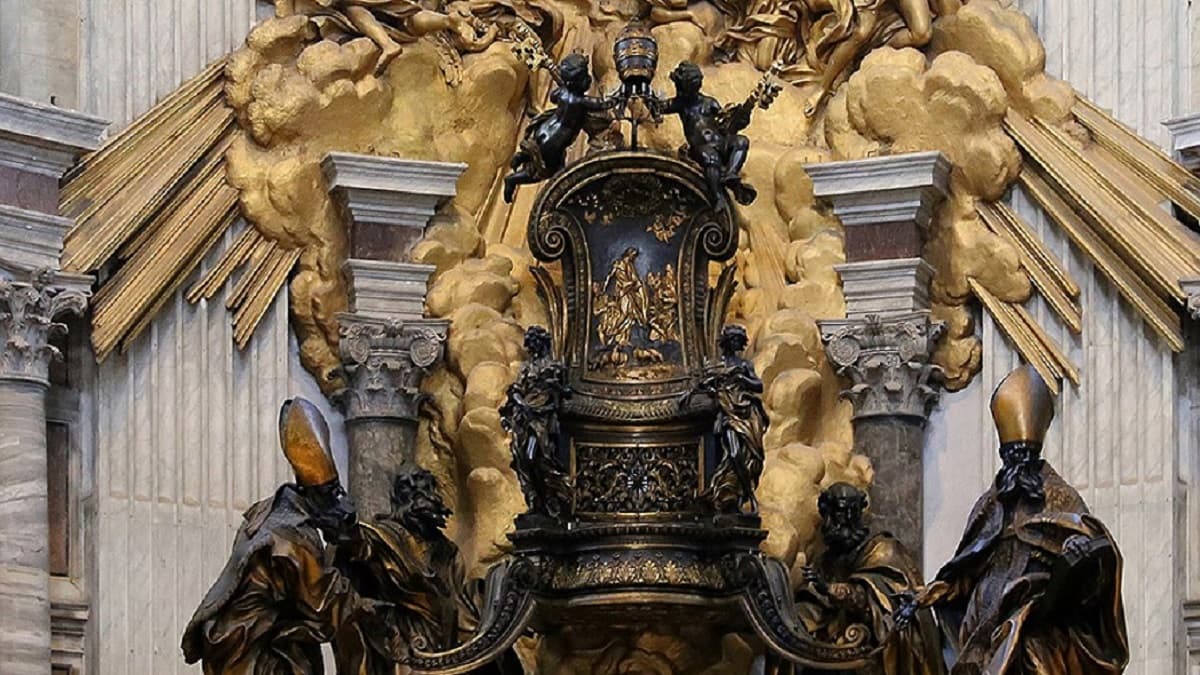The Chair of Saint Peter: Theological Meaning
In ancient Rome, ‘la cattedra'—the' chair or throne—was the seat of notables: magistrates, officials, or teachers. For Christians, it is the chair of high ecclesiastical authorities.
The Chair of St. Peter is the throne that, according to tradition, was donated by Saint Pudens to the apostle in order for him to perform his pontiff faculties in Rome; it symbolizes the preeminent position of the pope—the heir of Peter—on Christianity.
A Wooden throne Inside a Bronze Throne
The bronze chair is the custodian of a relic that has been venerated for centuries: a wooden seat decorated in ivory that in the nineteenth century, and again in the 1900s with dendrological analysis, was established as medieval and not an early Christian gift, from Charles the Bald, a Carolingian ruler, to the Pope on the occasion of an imperial coronation.
Since the original is not visible, a copy is held in the Treasury of St. Peter.
Gian Lorenzo Bernini’s throne
With the reconstruction of the basilica, the chair was positioned in a triumphal arrangement that had never been seen before, in the center of the apse, the visual fulcrum of the building, thanks to Bernini and pope Alexander VII Chigi.
It was completed in 1666 after 10 years of work, with the help of 35 collaborators. The meastro was sixty years old and resisted the Sun King's, Louis XIV's, invitations to Paris in order to finish the works in St. Peter's.
The Altar of the Chair has a pyramidal structure, which starts from its base in black and white marble from France and jasper from Sicily with the Chigi crests, the base for the Doctors of the Western and Eastern Church, Augustine of Hippo, Ambrose, Athanasius, and John Chrysostom, from where the throne stands, decorated in bas-relief with stories of Peter.
The Doctors are 5.35 meters high, and their faces have dramatic expressions inspired by Hellenistic art (just think of the Laocoön in the Vatican Museums), and they represent both the struggle against heresy and support the primacy of Rome.
A total of 74,000 kg of partly gilded bronze. The chair is 7 meters high, and the whole structure reaches 15 meters in height.
Bernini is a skilled'set ‘designer' and places his creations as if they were on a theater stage. The play of light that colors the sculptures, the pathos of the faces, and the dynamism of the fluid forms—these are the tools of the Baroque rhetoric of persuasion and emotion, aimed at involving the spectator.
The dove of the Holy Spirit in the Window above the Throne
In the invoices of payment, this part is called the "splendor.".
Above the throne, in a whirlwind of clouds, rays of sunlight, and angels (in gilded stucco), there is the oval window of the "Gloria" with the dove of the Holy Spirit (whose wingspan is 162 cm) that at sunset seems to burst into flame since the apse faces the west.
Angels are another Berninian specialty (just think of the Sant'Angelo bridge): with delicate and languid faces, fluttering clothes, and hands resting on their chests to express emotion.
The window is a copy of the original, which shattered on November 5, 1943, due to five bombs that were dropped on the Vatican, damaging several buildings. Allies and Nazi-Fascists exchanged mutual accusations for attacking a neutral state. The event remains a dark page of the civil war into which Italy had fallen after the armistice of September 8th, 1943.
Feast of the Chair of Saint Peter
In the Roman calendar there is a festival dedicated to the Chair of St. Peter, which dates back to the 3rd century and is celebrated on February 22nd.

Vox City, The Vox Group's Dedicated Business-To-Consumer Arm For The Past Five Years, Is Staffed By Veteran Travel Industry Experts With A Combined 21 Years Of Expertise In The Tourism Industry. Let's Explore The Beauty Of Travel In Your Own Way At Your Own Pace.
Vox City International 63 Holly Walk | CV32 4JG Leamington Spa
2025 Vox City, All rights reserved.





